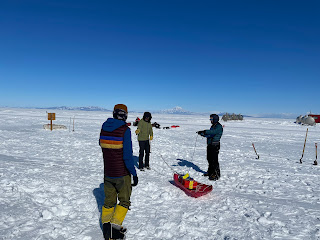Yesterday was a busy day!
My field team took a trip out onto the Ross Ice Shelf to practice finding buried equipment.
This is a particularly important task because a few of our seismic
stations are buried under several meters of snow. Some of these stations
send us GPS coordinates of their location, but the coordinates are not
that precise. Also, one of our stations is completely dead and has not
been sending GPS coordinates for a year, and the ice may have moved it
significantly from the old coordinates.
To help us locate our buried stations, we are planning on using a GPR unit: Ground Penetrating Radar. You pull the GPR transmitter across the snow, and it sends out a wave through the ground. The wave will bounce off of certain materials under ground, and bounce back into the unit. It then calculates how deep the reflection was based on the travel time of the wave.
GPR is pretty neat; there is a science group down right now that will be using GPR to image the ice underneath Thwaites Glacier. However, my team doesn't need a particularly fancy unit. We just need it to locate our buried stations, which should only be a few meters below the surface.
We arranged for a shuttle to drive us out onto the ice sheet and drop us off, and made sure to let the McMurdo communications building know we were leaving and when we expected to get back. We took a radio and survival bags with us. Even though the weather was clear and sunny when we left, the weather in Antarctica can change suddenly, so you are required to bring survival bags for everyone in your group whenever you leave the station.
 |
| Enjoy this picture of me looking heckin cool in my rad glacier glasses. That's Mt. Erebus off to the right. |
We also packed snacks, water, all our ECW, and our newly-issued pee bottles.
 | |
| My beautiful pee bottle. I have not had to use it yet. | |
We brought some pieces of the aluminum frame for the solar panels at our stations. The solar panel frames are 6-8 feet above the ground when we install the stations, and we are expecting the snow to have accumulated to the top of or above the solar panels. So we dug a hole and buried the aluminum frame. Then, we set up the GPR and pulled it across the area on a sled.
 |
| My team pulling the GPR on a sled. We have very little idea what we are doing. |
Unfortunately, GPR is difficult to do, and none of us are experts. We luckily had roped in a professor on a different field team who eventually helped us set up the correct parameters (after letting us struggle for a few hours, of course.....). Before he helped us out, we actually almost lost the aluminum we had buried. We couldn't find it with the GPR and had forgotten to mark where it was buried, so we dug up a lot of snow to find it again........
 |
| took a break from digging to take this picture. We are searching the whole area for our buried equipment.. |
After our mostly unsuccessful GPR attempt, we took a shuttle back to McMurdo in time for the eclipse. The path of the total solar eclipse went through part of West Antarctica, including WAIS, the field camp that we will be headed out to soon. Here in McMurdo, we got to experience a partial eclipse, with about 83% coverage at the peak. The eclipse path went from east to west, which is apparently only possible at the poles.
Seeing the eclipse with all of McMurdo station was such a special experience. Nearly everyone on station went out to watch, making this the largest group to ever view an eclipse in Antarctica (probably not a very difficult record to break). Most people (including myself) walked out on the sea ice to get a good view.
 |
| You can see the line of people out on the sea ice to watch the eclipse. So cool! |
 |
| Giant pinhole camera. Also a great place to warm up after stepping off the ice. |
 |
| A picture from inside the pinhole camera. You can see the crescent shape of the sun. This was taken as the eclipse was ending. |
More pictures upcoming! I went on a truly exceptional hike today (day 6), and it deserves a post to itself.
Comments